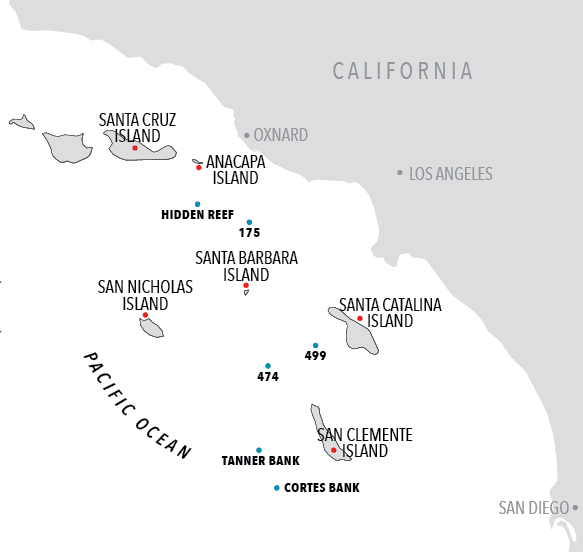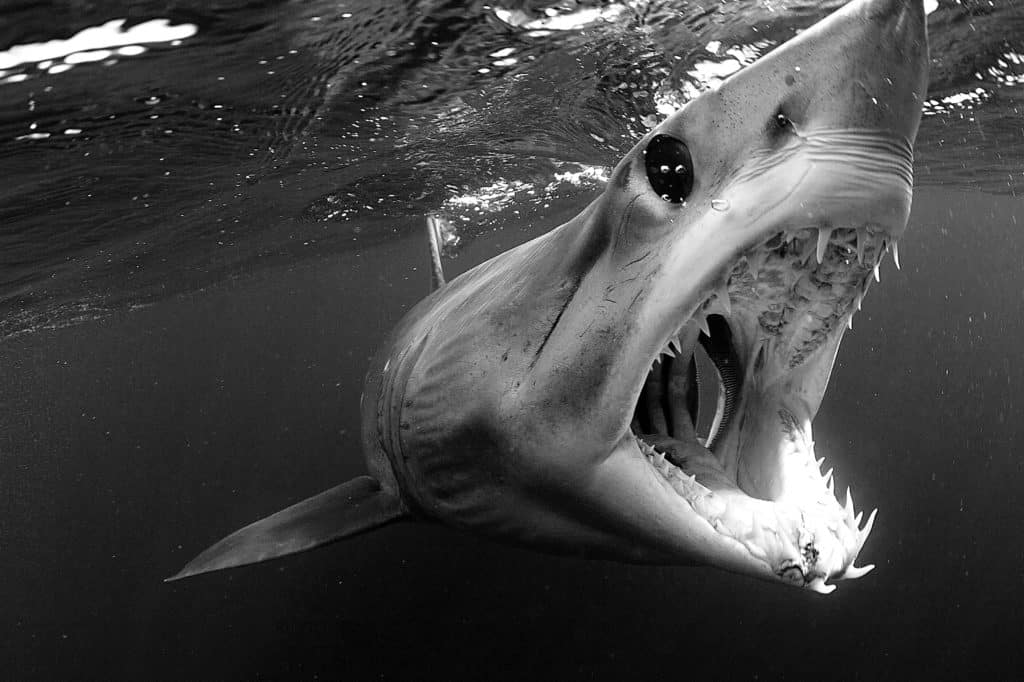
From the cockpit of the 29-foot Strike Zone, Capt. Steve Quinlan and deck boss Joshua Hendricks scan the 4-mile-long chum slick. They see the nervous fluttering of sea birds. Soon the mackerel in the slick — and the sea lions feeding on them — beat a hasty retreat. A mako has crashed the party.
“I’m bit,” snaps Hendricks. With that, Quinlan starts the outboards and throttles ahead as Hendricks throws the reel in gear. Immediately, a 700-pound mako explodes 10 feet skyward — uncorking a cartwheeling vault — crashes back down, then smokes away on a 200-yard sprint. Team Strike Zone settles in for a long battle.
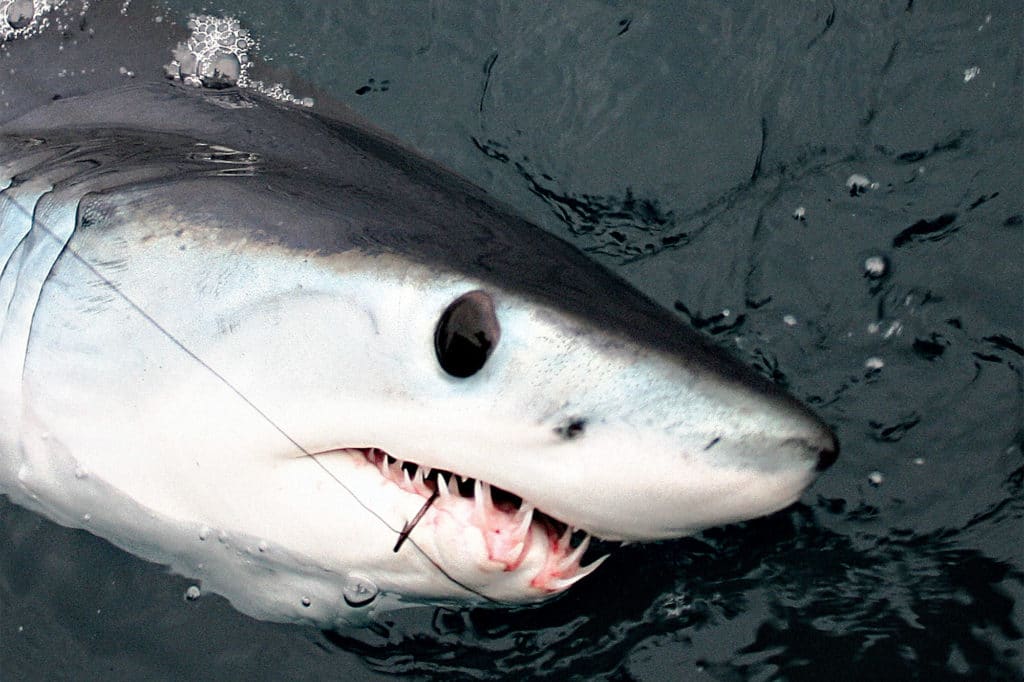
When: June through October Jim Hendricks
Dangerous Game
If you’re up for the challenge, Southern California offers consistent action for monster mako sharks, one of the world’s largest and most dangerous game fish.
Few exceed Quinlan’s experience with these impressive predators. Before adopting a catch-and-release policy, Quinlan weighed in more than a dozen makos over 500 pounds, including four over 700 pounds and three in excess of 1,000, topped by a 1,175-pounder. Since then, his team has released five fish over 1,000 pounds, including one estimated at more than 1,400 pounds.
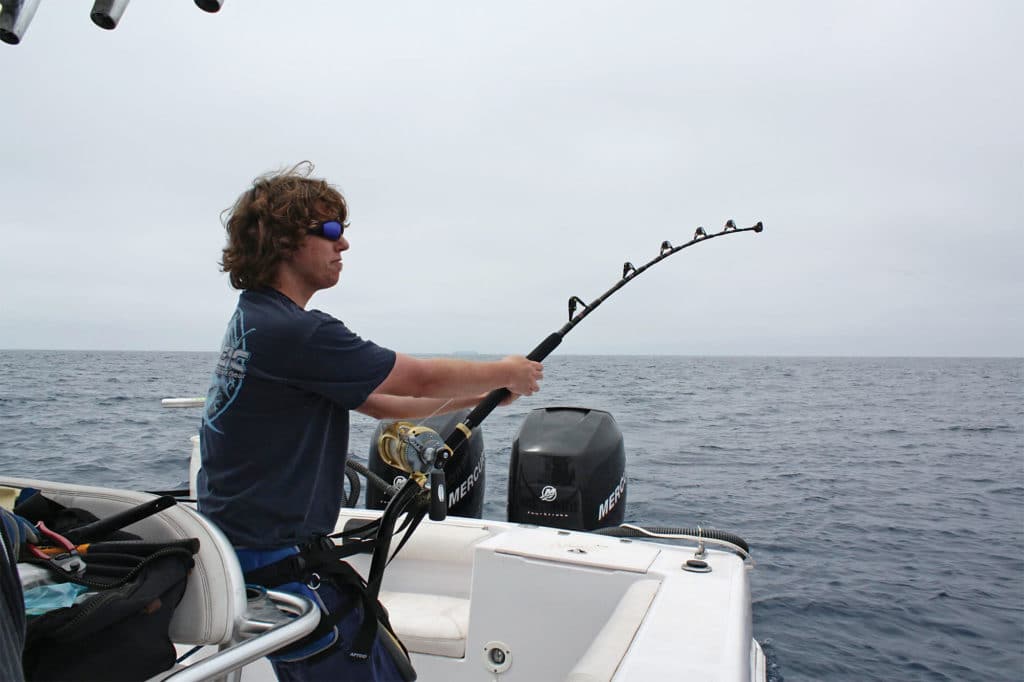
Seamount Savvy
Research indicates mako sharks detect bottom features even when they can’t see them. In a California study, a tagged mako on the surface followed the contours of a canyon hundreds of feet below. “Structure creates upwellings of nutrient-rich water that attracts plankton,” says Quinlan. This attracts prey fish, and at the top of food chain is the mako.
Water conditions also play a role, says Quinlan. He looks for blue water — purple-blue water is best — with temperatures from 65 to 71 degrees. He studies temperature and chlorophyll charts looking for high spots where the right temperature and low chlorophyll content, an indication of blue water, coincide.
Quinlan also looks for the best wind and current. “You want the current opposing the wind,” he explains. “The wind keeps the boat moving in one direction while the current carries the chum in the opposite direction. This extends the chum slick and increases the chances of a mako finding the scent.”
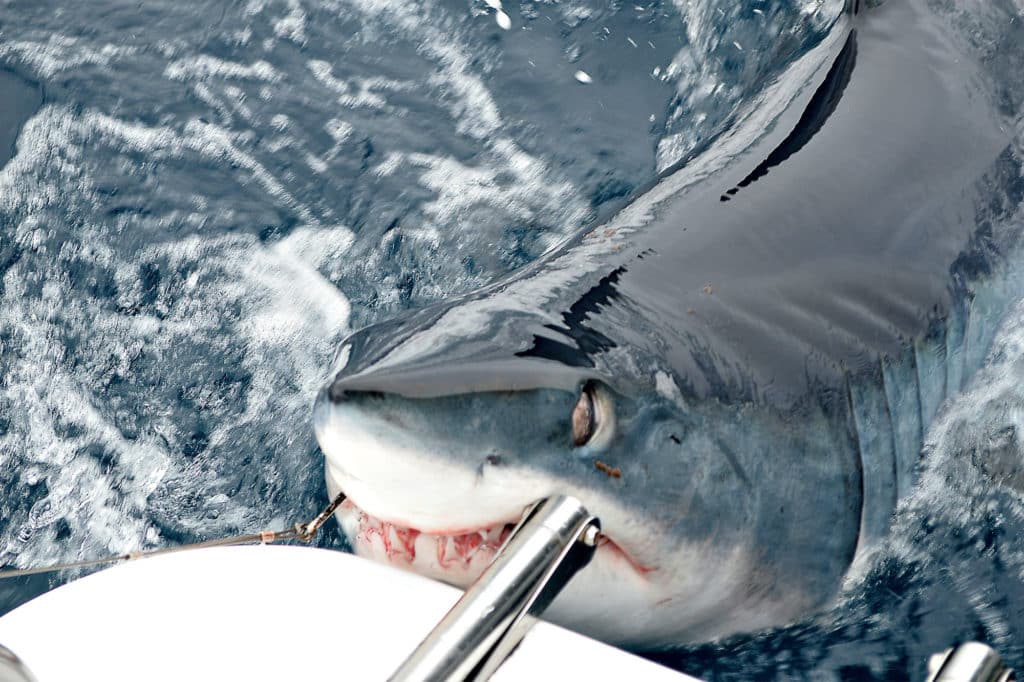
Get Chummy
Chumming has proven to be the most effective method of attracting world-class makos. “Fresh fish is the best,” Quinlan says. “I buy in bulk and grind it myself. It takes a day to produce enough chum for a one-day charter.” Fillets and belly meat of tuna are best, but Quinlan also uses bonito and Pacific barracuda to create shoebox-size frozen blocks. He carries 200 to 300 pounds for each trip, as well as dozens of fish carcasses.
Quinlan uses two 5-gallon Slick Master chum buckets (one on each stern quarter) for dispersing the blocks and a gunnysack or two for hanging carcasses over the side. Every 10 minutes, he pulls the gunnysack onto the swim step and stomps on it to release as much scent as possible.
To get a head start on the chumming process, Quinlan uses a technique he calls “power chumming,” which is particularly helpful when there is no wind.
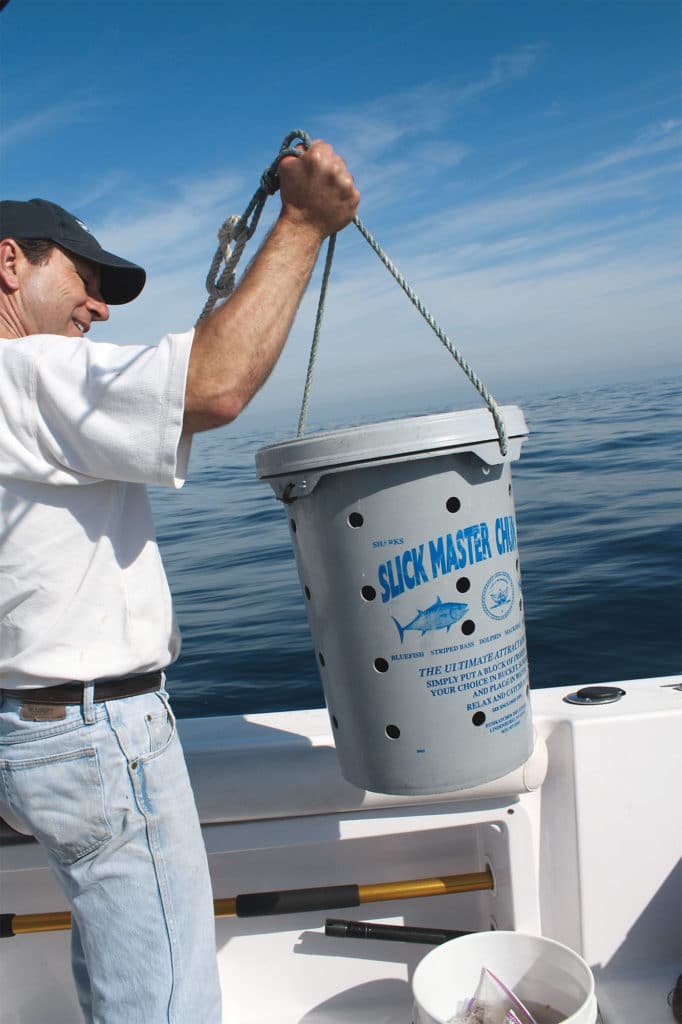
“We put out the chum buckets and then motor at 3 or 4 knots toward and across the structure we want to fish,” he explains. “We do this for about 2 miles, and then we shut down and drift.”
Ideally, Quinlan likes to begin the chum slick about a mile or two upwind of the target area and power chum downwind, so he begins the drift slightly downwind of the structure. “We’ve caught fish on and around the high spot, but mostly to the inside (downwind) because our slick has covered more territory by then,” he says.
While most anglers try to avoid sea lions when fishing, Quinlan considers them an ally. Like great whites, mako sharks feed on sea lions. “If a mako smells sea lion poop in the slick, she knows she’s on the right track,” Quinlan says.
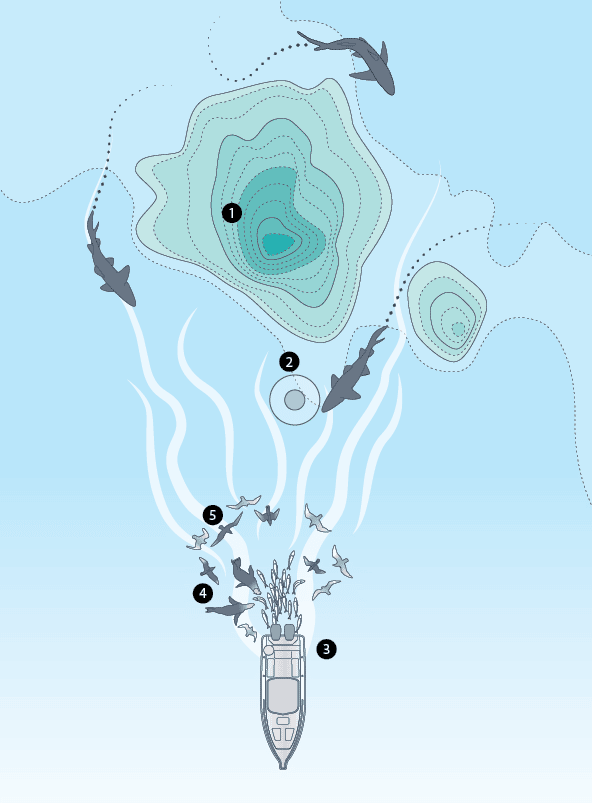
Habitat: Big mako sharks hang over structure where bait and sea lions — their preferred prey — gather.
Attractant: Set up a steady chum line, which can stretch for several miles, to draw makos within baiting range.
Steady flow: A couple hundred pounds of ground fresh fish makes the chum line most effective.
True tell: Sea lions provide a reliable clue to finding big mako sharks, which can smell them in the water, and home in on their primary food source.
Locators: Birds are the best indicator of the presence of bait, which attracts sea lions and, in turn, the makos.
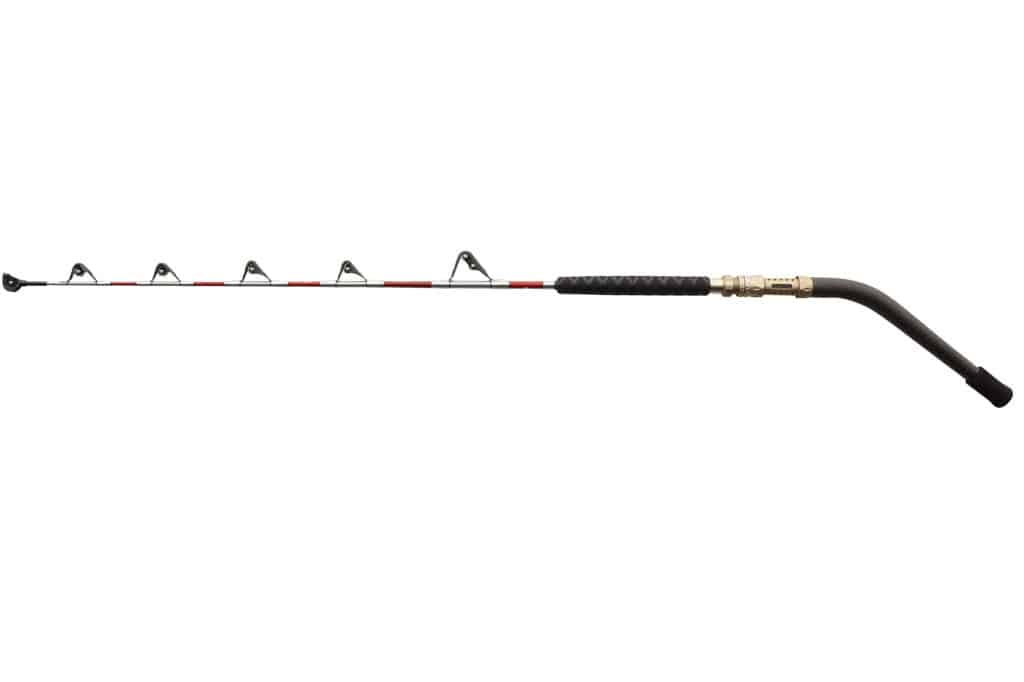
Wait to Bait
Team Strike Zone doesn’t put a bait in the water until they eyeball a fish they want to catch. Once the team spots a trophy-size mako, things gets serious. Quinlan emphasizes the importance of teamwork. “Josh and I already know who is going to toss the bait, who drives the boat and who is going to fight the fish before a mako ever shows up,” he says.
Most makos charge in hot and ready to eat, Quinlan says. Yet there are some tricks to baiting them. The bait should match the chum, Quinlan believes. “If you’re chumming with bonito or barracuda, you wouldn’t throw the fish a squid.” Avoid using whole fish. The shark is eating pieces of chum, so it won’t hesitate to eat another piece, such as a slab of belly meat. It’s also easier to sink the hook into the mako with a smaller piece of bait.
With the heavy tackle used for monster makos, you really can’t cast. So Hendricks literally pitches a bait to a charging mako. “You don’t have to get too close,” he says. “These fish swim for a living and can usually find the bait on their own.
“Yet, you want to get it away from the boat, so the fish doesn’t swim underneath the hull and tangle the line in the running gear before you even get a chance to set the hook.”
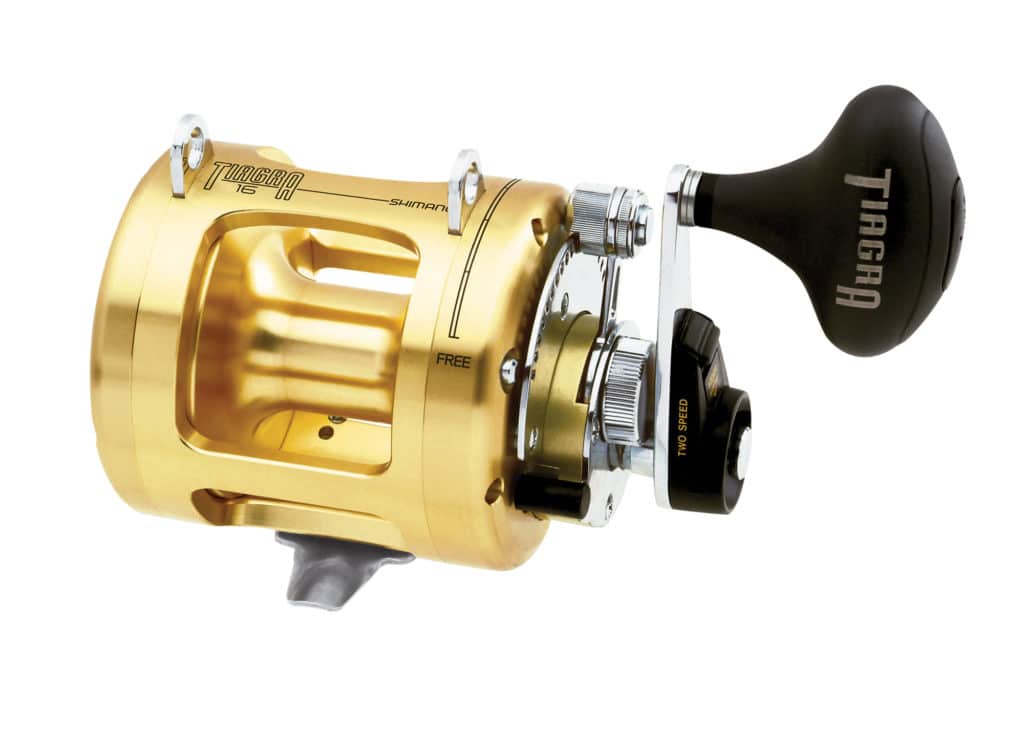
Shimano Tiagra 50W
Keep Moving
Once a fish picks up the bait, Quinlan motors away while the angler puts the reel in gear and sets the hook.
“You want to keep the shark at a respectable distance, off either corner of the transom,” Quinlan says. Rambunctious makos have been known to leap into the boat.
Quinlan learned years ago to keep the boat moving while fighting a huge mako. He once lost a big fish when he pulled the engine out of gear near the end of the battle, and the fish crossed under the boat and broke off.
“Keep moving. That puts you in control,” he says. “We also change directions often to keep the fish from getting comfortable. That usually forces them to run or jump, and that’s what wears them down.
“There’s no sense in pressuring a big fish early. You want a big mako tired when it’s close to the boat,” he says. The team knows that the endgame is near when the fish’s dorsal and tail are out of the water. With the boat idling forward and the angler drawing the fish near, Hendricks leaders it. If it lunges, he lets go and Quinlan motors away. If not, he holds the fish boat-side while Quinlan slides aft to remove the hook and release the fish. If the hook is deep, they use cable cutters to release the shark.
Catching a fish that’s 10 feet long, 4 feet wide and capable of inflicting deadly wounds with its teeth and tail might not be for everyone. Success hinges on dedication, the right equipment, and confidence in your crew.
This is what it takes to score monster makos.
